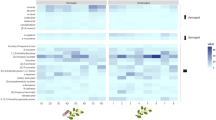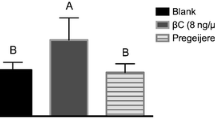Abstract
Fifteen synthetic herbivore-induced plant volatiles (HIPVs) were field-tested for attractivity to beneficial insects in two experiments conducted in an open field and a hop yard in Washington State. Eleven insect species or families showed significant attraction to 13 HIPVs. The ladybeetle, Stethorus punctum picipes, was attracted to sticky traps baited with methyl salicylate (MeSA), cis-3-hexen-1-ol (He), and benzaldehyde (Be). The minute pirate bug, Orius tristicolor, was attracted to traps baited with MeSA, He, Be, and octyl aldehyde (Oa), and the bigeyed bug, Geocoris pallens, responded to MeSA, indole, and trans-2-hexen-1-al. The mymarid wasp, Anagrus daanei, was attracted to He, Oa, and farnesene. The chloropid fly, Thaumatomyia glabra, was highly attracted to methyl anthranilate. Insect families responding to HIPVs included Syrphidae (MeSA, He), Braconidae ((Z)-3-hexenyl acetate, He, cis-jasmone (J), methyl jasmonate (MeJA), methyl anthranilate (MeA)), Empididae (MeSA), Sarcophagidae (MeSA, Be, J, nonanal and geraniol), Tachinidae (Be), and Agromyzidae (MeSA). Micro-Hymenoptera (primarily parasitic wasp families) were attracted to MeSA, He, and indole. These results are discussed with respect to known properties and bioactivity of the tested HIPVs and to their potential as tools for recruiting natural enemies into agroecosystems.
Similar content being viewed by others
References
ARONOV, E. V. and CLARK, L. 1996. Degradation studies of the non-lethal bird repellent, methyl anthranilate. Pestic. Sci. 47:355–362.
BIRKETT, M. A., CHAMBERLAIN, K., GUERRIERI, E., PICKETT, J. A., WADHAMS, L. J., and YASUDA, T. 2003. Volatiles from whitefly-infested plants elicit a host-locating response in the parasitoid, Encarsia Formosa. J. Chem. Ecol. 29:1589–1600.
BOEVE, J. L., LENGWILER, U., TOLLSTEN, L., DORN, S., and TURLINGS, T. C. J. 1996. Volatiles emitted by apple fruitlets infested by larvae of the European apple sawfly. Phytochemistry 42:373–381.
BRUIN, J. and DICKE, M. 2001. Chemical information transfer between wounded and unwounded plants: Backing up the future. Biochem. Syst. Ecol. 29:1103–1113.
BUCHBAUER, G., JIROVETZ, L., WASICKY, M., and NIKIFOROV, A. 1993. Headspace and essential oil analysis of apple flowers. J. Agric. Food Chem. 41:116–118.
DE GREET, P. and POLand, T. M. 2003. Attraction of Hylastes opacus (Coleoptera: Scolytidae) to nonanal. Can. Entomol. 135:309–311.
DICKE, M. 1999. Are herbivore-induced plant volatiles reliable indicators of herbivore identity to foraging carnivorous arthropods? Entomol. Exp. Appl. 91:131–142.
DICKE, M., SABELIS, M. W., TAKABAYASHI, J., BRUIN, J., and POSTHUMUS, M. A. 1990a. Plant strategies of manipulating predator-prey interactions through allelochemicals: Prospects for application in pest control. J. Chem. Ecol. 16:3091–3118.
DICKE, M., VAN BEEK, T. A., POSTHUMUS, M. A., BEN DOM, N., VAN BOKHOVEN, H., and DE GROOT, A. E. 1990b. Isolation and identification of volatile kairomone that affects acarine predator-prey interactions. J. Chem. Ecol. 16:381–396.
DICKE, M., TAKABAYASHI, J., POSTHUMUS, M. A., SCHUTTE, C., and KRIPS, O. E. 1998. Plant-phytoseiid interactions mediated by herbivore-induced plant volatiles: variation in production of cues and in responses of predatory mites. Exp. Appl. Acarol. 22:311–333.
DU, Y., POPPY, G. M., POWELL, W., PICKETT, J. A., WADHAMS, L. J., and WOODCOCK, C. M. 1998. Identification of semiochemicals released during aphid feeding that attract the parasitoid, Aphidius ervi. J. Chem. Ecol. 24:1355–1368.
ENGELBERTH, J., ALBORN, H. T., SCHMELZ, E. A., and TUMLINSON, J. H. 2004. Airborne signals prime plants against insect herbivore attack. Proc. Nat. Acad. Sci. USA 101:1781–1785.
FUKUSHIMA, J., KAINOH, Y., HONDA, H., and TAKABAYASHI, J. 2002. Learning of herbivore-induced and non-specific plant volatiles by a parasitoid, Cotesia kariyai. J. Chem. Ecol. 28:579–586.
HAN, B. and CHEN, Z. 2002. Behavioral and electrophysiological responses of natural enemies to synomones from tea shoots and kairomones from tea aphids, Toxoptera aurantii. J. Chem. Ecol. 28:2203–2219.
JAMES, D. G. 2003a. Field evaluation of herbivore-induced plant volatiles as attractants for beneficial insects: methyl salicylate and the green lacewing, Chrysopa nigricornis. J. Chem. Ecol. 29:1601–1609.
JAMES, D. G. 2003b. Synthetic herbivore-induced plant volatiles as field attractants for beneficial insects. Environ. Entomol. 32:977–982.
JAMES, D. G. and PRICE, T. S. 2004. Field-testing of methyl salicylate for recruitment and retention of beneficial insects in grapes and hops. J. Chem. Ecol. 30:1595–1610.
KESSLER, A. and BALDWIN, I. T. 2001. Defensive function of herbivore-induced plant volatile emissions in nature. Science 291:2141–2144.
KNUDSEN, J. T., TOLISTEN, L., and BERGSTROM, L. G. 1993. Floral scents- a checklist of volatile compounds isolated by headspace techniques. Phytochemistry 33:253–280.
LANDOLT, P., WIXON, T., REMKE, L. J., LEWIS, R. R., and ZACK, R. S. 2000. Methyl anthranilate attracts males of Thaumatomyia glabra (Meigen) (Diptera: Chloropidae). J. Kansas. Entomol. Soc. 73:189–194.
LESKEY, T. C., PROKOPY, R. J., WRIGHT, S. E., PHELAN, P. L., and HAYNES, L. W. 2001. Sources of apple odor attractive to adult plum curculios (Coleoptera: Curculionidae). J. Chem. Ecol. 26:639–653.
MURAI, T., IMAI, T., and MAEKAWA, M. 2000. Methyl anthranilate as an attractant for two thrips species and the thrips parasitoid, Ceranisus menes. J. Chem Ecol. 26:2557–2565.
MOLLEMAN, F., DRUKKER, B., and BLOMMERS, L. 1997. A trap for monitoring pear psylla predators using dispensers with the synomone methyl salicylate. Proc. Exper. & Appl. Entomol. N.E.V. Amsterdam 8:177–182.
PARE, P. W. and TUMLINSON, J. H. 1996. Plant volatile signals in response to herbivore feeding. Fla. Entomol. 19:93–103.
PARE, P. W. and TUMLINSON, J. H. 1997. De novo biosynthesis of volatiles produced by insect herbivory in cotton plants. Plant Physiol. 114:1161–1167.
PARE, P. W., LEWIS, W. J., and TUMLINSON, J. H. 1999. Induced plant volatiles: Biochemistry and effects on parasitoids, pp. 167–180, in A. A. Agrawal, S. Tuzun, and E. Bent (eds.). Induced Plant Defenses Against Pathogens and Herbivores. APS Press, St Paul, Minnesota.
PARK, K. C., ZHU, J., HARRIS, J., OCHIENG, S. A., and BAKER, T. C. 2001. Electroantennogram responses of a parasitic wasp, Microplitis croceipes to host-related volatile and anthropogenic compounds. Physiol. Entomol. 26:69–77.
PELLMYR, O. 1986. Three pollination morphs in Cimicifuga simplex: Incipient speciation due to inferiority in competition. Oecologia 68:304–307.
PLEPYS, D., IBARRA, F., FRANCKE, W., and LOFSTEDT, C. 2002. Odour-mediated nectar foraging in the silver Y moth, Autographa gamma (Lepidoptera: Noctuidae): Behavioural and electrophysiological responses to floral volatiles. Oikos 99:75–82.
SABELIS, M. W., JANSSEN, A., PALLINI, A., VENZON, M., BRUIN, J., DRUKKER, B., and SCUTAREANU, P. 1999. Behavioral responses of predatory and herbivorous arthropods to induced plant volatiles: from evolutionary ecology to agricultural applications, pp. 269–296, in A. A. Agrawal, S. Tuzun, and E. Bent (eds.). Induced Plant Defenses Against Pathogens and Herbivores. APS Press, St Paul, Minnesota.
SCUTAREANU, P., DRUKKER, B., BRUIN, J., POSTHUMUS, M. A., and SABELIS, M. W. 1997. Volatiles from psylla-infested pear trees and their possible involvement in attraction of anthocorid predators. J. Chem. Ecol. 23:2241–2260.
SCUTAREANU, P., BRUIN, J., POSTHUMUS, M. A., and DRUKKER, B. 2003. Constitutive and herbivore-induced volatiles in pear, alder and hawthorn trees. Chemoecology 13:63–74.
STERN, D. J., LEE, A., MCFADDEN, W. H., and STEVENS, K. L. 1967. Volatiles from grapes. Identification of volatiles from concord essence. J. Agric. Food Chem. 15:1100–1103.
STOWE, M. K., TURLINGS, T. C. J., LOUGHRIN, J. H., LEWIS, W. J., and TUMLINSON, J. H. 1995. The chemistry of eavesdropping, alarm and deceit. Proc. Nat. Acad. Sci. USA. 92:23–28.
SUMMERS, C. G. and NEWTON, A. S. 1989. Economic significance of sugarbeet root aphid, Pemphigus populivenae Fitch (Homoptera: Aphididae) in California. Appl. Agric. Res. 4:162–167.
TAKABAYASHI, J. and DICKE, M. 1996. Plant-carnivore mutualism through herbivore-induced carnivore attractants. Trends in Plant Sci. 1:109–113.
THALER, J. S. 1999. Jasmonic acid mediated interactions between plants, herbivores, parasitoids and pathogens: A review of field experiments in tomato, pp. 319–334, in A. A. Agrawal, S. Tuzun, and E. Bent (eds.). Induced Plant Defenses Against Pathogens and Herbivores. APS Press, St Paul, Minnesota.
TSCHARNTKE, T., THIESSEN, S., DOLCH, R., and BOLand, W. 2001. Herbivory, induced resistance, and interplant signal transfer in Alnus glutinosa. Biochem. Syst. Ecol. 29:1025–1047.
TURLINGS, T. C. J., TUMLINSON, J. H., and LEWIS, W. J. 1990. Exploitation of herbivore-induced plant odors by host-seeking parasitic wasps. Science 250:1251–1253.
TURLINGS, T. C. J., TUMLINSON, J. H., ELLER, F. J., and LEWIS, W. J. 1991. Larval-damaged plants: Source of volatile synomones that guide the parasitoid, Cotesia marginiventris to the microhabitat of its hosts. Entomol. Exp. Appl. 58:75–82.
VAN DEN BOOM, C. E. M., VAN BEEK, T. A., POSTHUMUS, M. A., DE GROOT, A., and DICKE, M. 2004. Qualitative and quantitative variation among volatile profiles induced by Tetranychus urticae feeding on plants from various families. J. Chem Ecol. 30:69–89.
VET, L. E. M. and DICKE, M. 1992. Ecology of infochemical use by natural enemies in a tritrophic context. Annu. Rev. Entomol. 37:141–172.
WHITMAN, D. W. and ELLER, F. J. 1990. Parasitic wasps orient to green leaf volatiles. Chemoecology 1:69–76.
WHITMAN, D. W. and ELLER, F. J. 1992. Orientation of Microplitis croceipes (Hymenoptera: Braconidae) to green leaf volatiles: Dose response curves. J. Chem Ecol. 18:1743–1753.
WHITMAN, D. W. and NORDLUND, D. A. 1994. Plant chemicals and the location of herbivorous arthropods by their natural enemies, pp. 133–158, in T. N. Ananthakrishnan (ed.). Functional Dynamics of Phytophagous Insects. Oxford & IBH Publishing Co., PVT. Ltd. New Delhi, India.
ZHU, J., COSSE, A. A., OBRYCKI, J. J., BOO, K. S., and BAKER, T. C. 1999. Olfactory reactions of the twelve-spotted lady beetle, Coleomegilla maculata and the green lacewing, Chrysoperla carnea to semiochemicals released from their prey and host plants: electroantennogram and behavioral responses. J. Chem Ecol. 25:1163–1177.
Author information
Authors and Affiliations
Corresponding author
Rights and permissions
About this article
Cite this article
James, D.G. Further Field Evaluation Of Synthetic Herbivore-Induced Plan Volatiles As Attractants For Beneficial Insects. J Chem Ecol 31, 481–495 (2005). https://doi.org/10.1007/s10886-005-2020-y
Received:
Accepted:
Issue Date:
DOI: https://doi.org/10.1007/s10886-005-2020-y




